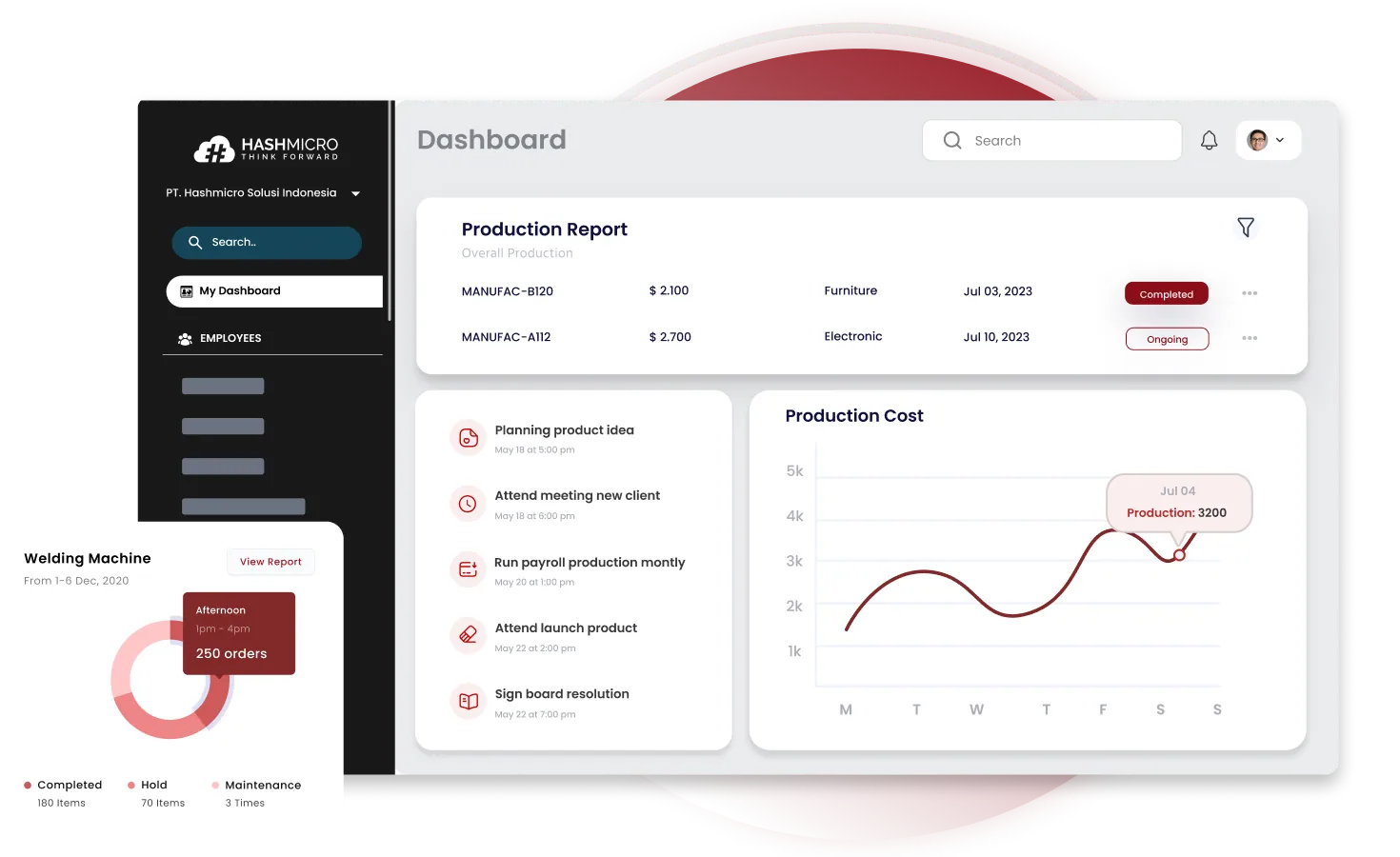RFID (Radio Frequency Identification) technology is crucial in modern asset management, inventory tracking, and logistics. It enables businesses to track and manage objects efficiently by using electromagnetic fields to identify and capture data stored in RFID tags.
When choosing the right RFID technology, understanding the difference between active and passive RFID tags is essential. These two types of RFID tags offer distinct features, advantages, and use cases that can significantly impact the efficiency of your operations.
So, how can businesses ensure they select the right RFID system for their needs? HashMicro’s Manufacturing Inventory System offers a comprehensive solution by integrating RFID technology to optimize inventory tracking, improve asset management, and streamline production processes.
In this article, we’ll dive into the differences between active and passive RFID tags, helping you determine which option best suits your needs.
Key Takeaways
|
Table of Content:
Table of Content
What is the Role of RFID Technology in Automation and Data Collection?
RFID technology is revolutionizing the way businesses manage their inventory, assets, and equipment. With the ability to accurately and efficiently track items in real-time, RFID systems have become an integral part of automation and data collection processes.
An RFID system consists of three main components: an RFID reader or interrogator, an RFID antenna, and RFID tags. These tags can be either passive or active, depending on their power source. Passive RFID tags rely on the energy transmitted from the reader to power them, while active RFID tags have their own internal power source, typically a battery.
The role of RFID technology in automation is significant. By automating the process of data collection and identification, businesses can streamline their operations, reduce human error, and improve overall efficiency. RFID systems enable automatic scanning and tracking of items, eliminating the need for manual entry and increasing productivity.
Moreover, RFID technology plays a crucial role in data collection. By tagging items with RFID tags, businesses can gather valuable information such as item location, movement, and usage patterns. This data can be used for inventory management, supply chain optimization, and asset tracking.
Various industries have adopted RFID technology to enhance their operations. In the logistics industry, RFID systems help track shipments, improve warehouse management, and enable efficient inventory management. In the education sector, RFID technology is employed for student attendance tracking and library book management. Similarly, in supply chain management and manufacturing, RFID systems enable real-time visibility and monitoring of assets and products.
Overall, RFID technology has become an indispensable tool for automation and data collection. Its ability to track items, provide real-time data, and streamline operations has made it a key component in various industries. As technology continues to advance, we can expect even more innovative applications of RFID technology in the future.
Hashy AI Fact RFID technology boosts business efficiency by automating data collection and reducing errors. Hashy AI in manufacture provides solutions to optimize RFID tracking and asset management. Request a free demo today!
Need to Know
What are Active RFID Tags?
Active RFID tags are small devices that play a vital role in asset tracking and management. Unlike passive RFID tags, active tags have their own internal power source, typically a battery, which allows them to continuously broadcast a unique radio identifier code.
There are two main variants of active RFID tags: transponder and beacon. Transponder active tags listen for a request from an RFID reader and transmit data only when prompted. On the other hand, beacon active tags continuously send a signal, enabling continuous tracking and monitoring.
Active RFID tags offer several key features that make them highly effective in various applications. They have a longer read range, enabling greater coverage and accuracy when tracking assets. Their higher performance allows for faster data capture and processing. These tags are commonly used in industries such as logistics and supply chain management, where real-time tracking and monitoring of valuable assets are crucial.
The operational mechanism of active RFID tags involves constantly broadcasting their unique code, allowing RFID readers to capture the signal and identify the tagged asset. This mechanism ensures accurate and reliable asset tracking in dynamic environments.
Some typical applications of active RFID tags include tracking high-value equipment, monitoring asset movement within facilities, and managing container tracking in busy shipping yards. Active RFID tags provide a robust and efficient solution for real-time asset visibility and management.
Advantages and Disadvantages of Active RFID Tags
Active RFID tags offer several advantages that make them suitable for specific applications in Singapore. Firstly, they provide an extended read range of over 100 meters, allowing for efficient tracking of assets and inventory across large facilities or outdoor areas. This extended range is particularly useful in industries such as logistics, where the movement of goods needs to be closely monitored.
Another advantage of active RFID tags is their larger memory capacity for storing data. This enables the tags to capture and transmit more information, such as timestamps, sensor readings, and location coordinates. The ability to store and retrieve this data is crucial for accurate asset tracking and real-time monitoring.
Active RFID tags also have higher performance capabilities compared to passive tags. They can operate in high-speed environments without compromising accuracy or read speeds, making them ideal for applications that require real-time tracking or quick data capture.
However, it’s important to consider the disadvantages of active RFID tags as well. One major drawback is the higher cost associated with these tags. Due to their complex design and additional features, active RFID tags are more expensive than passive tags. This cost factor needs to be carefully considered when planning RFID deployments, especially for large-scale implementations.
Another disadvantage of active RFID tags is their dependency on batteries for power. While the inclusion of a battery enables continuous broadcasting of the tag’s signal, it also means that the batteries need to be replaced when their life span ends. This ongoing battery replacement can add to the maintenance costs and logistical challenges of managing a large number of active tags.
What are Passive RFID Tags?
Passive RFID tags are a type of radio frequency identification technology that consists of an antenna connected to an integrated circuit. These tags operate without an internal power source and rely on an RFID reader to transmit a radio signal. It is this signal that powers the tag and allows it to send back the stored data.
Compared to their active counterparts, passive RFID tags have a simpler design and do not require a built-in battery. This makes them more cost-effective and compact in size, making them suitable for various applications.
Passive RFID tags are commonly used in Singapore for inventory management, asset tracking, and individual product tagging. They enable businesses to streamline their operations, improve efficiency, and enhance supply chain management.
With their operational mechanism that functions without internal power sources, passive RFID tags provide a reliable and efficient solution for businesses in Singapore to implement RFID technology in their operations.
Advantages and Disadvantages of Passive RFID Tags
Passive RFID tags are widely used in Singapore due to their affordability and versatility. Their compact design makes them ideal for integration into stickers, cards, and other small form factors, making them especially useful for supply chain management and inventory tracking.
The key advantages of passive RFID tags include cost-effectiveness, compactness, and flexibility, allowing them to be easily embedded into various items. They require no battery, making them maintenance-free and suitable for long-term use in static applications.
However, passive RFID tags have limitations, such as a shorter read range that makes them unsuitable for long-distance tracking. Their data storage is also limited, and performance can be affected by environmental factors like metal or liquid interference.
Despite these drawbacks, passive RFID tags remain a practical solution for many businesses. Their cost-efficiency and ease of use continue to drive adoption, especially when compact size and battery-free operation are more important than high data capacity or long-range communication.
Semi-Passive RFID Tags: An Overview of Battery-Assisted Passive Technology
Semi-passive RFID tags, also known as battery-assisted passive tags, offer a unique position in the realm of RFID technologies. Combining features from both active and passive tags, these innovative tags provide a balance between functionality and power efficiency.
Unlike active RFID tags that rely on continuous battery-powered transmission, semi-passive tags utilize an internal battery to assist in powering the tag. This enables them to offer real-time tracking and sensor capabilities while still maintaining a longer battery life compared to active tags.
The main advantage of semi-passive RFID tags is their ability to provide real-time tracking and data collection without the need for constant battery usage. This makes them particularly suitable for applications that require environmental monitoring, such as temperature-controlled transit. For example, in Singapore’s logistics industry, semi-passive RFID tags can be used to track perishable goods during transportation, ensuring optimal conditions are maintained.
With their unique combination of features, semi-passive RFID tags fill a gap between active and passive technologies, offering enhanced functionality and power efficiency. As the demand for real-time tracking and sensor capabilities continues to grow, semi-passive RFID tags are becoming increasingly relevant in a variety of industries, including healthcare, retail, and manufacturing.
Making the Right Choice: Comparative Analysis and Future Trends
When it comes to choosing between active and passive RFID systems, cost is a key consideration. While active RFID systems may have a higher upfront cost, it’s important to assess factors such as the desired read range, memory capacity, and additional features to accurately compare costs. On the other hand, passive RFID systems are more cost-effective for mass deployment and applications with shorter read ranges.
However, cost should not be the sole determining factor in selecting the appropriate RFID type for your business. Performance, range, application environments, and cost-effectiveness must also be taken into account. Analyzing these aspects will ensure that you choose the appropriate RFID technology that aligns with your specific needs.
Looking ahead, there are exciting future trends in RFID technology. The integration of IoT with RFID will enable enhanced data collection and analysis, leading to more accurate and real-time insights. Furthermore, advancements in chip technology will drive the evolution of both active and passive RFID tags, improving their performance and expanding their use cases in different industries.
Conclusion
In the realm of RFID technology, the choice between active and passive RFID tags is pivotal for optimizing asset tracking and inventory management processes. Understanding the functionalities, applications, and considerations associated with each type is crucial for businesses to make informed decisions. While active RFID tags offer extended capabilities for real-time tracking, passive RFID tags provide cost-effective solutions for various applications. Additionally, the emergence of semi-passive RFID tags bridges the gap between functionality and power efficiency, offering enhanced capabilities with longer battery life.
By implementing HashMicro’s Manufacturing Software, companies can better manage stock, reduce lost or missing items, and improve production efficiency. Moreover, with advanced analytics features, the software also enables companies to analyse data from RFID Tags, identify trends, and make smarter decisions in their production planning and supply chain management. Thus, the use of HashMicro’s Manufacturing Software can help businesses increase efficiency, reduce costs, and improve overall productivity.
Get 70% funding from CTC Grant and try HashMicro’s free demo now to get to know how our features can support your business!
Frequently Asked Questions
-
What is the difference between active and passive RFID?
Passive RFID tags don’t have their own power source and rely on external signals for operation. In contrast, Active RFID tags are self-powered and continuously transmit signals through their built-in battery and transmitter.
-
What is active RFID used for?
Active RFID uses battery-powered tags that constantly send data, allowing for real-time tracking over long distances.
-
What are the benefits of passive RFID?
Passive RFID offers many proven benefits, including improved efficiency, real-time visibility, cost savings, and better security, all of which contribute to enhanced operational performance.


























































